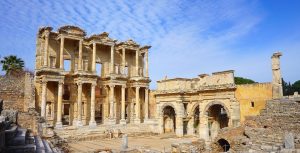Ancient Ephesus Marbles
It turned out that the blocks from the ancient marble quarry, located in the Kizilagac area at an altitude of 400 meters on the upper part of the Saglik Mountain, were transported to the city of Ephesus, which is the first city in history to be made of marble.
The ancient marble quarry, located in the Kizilagac area at an altitude of 400 meters on the upper part of the Saglik Mountain, carries the mystery of witnessing a history even though it is secluded. It is known that the marble blocks excavated from here were transported to the city of Ephesus, which is the first city made of marble in history. Archaeologists estimate that these marble blocks were transported to Ephesus on rafts over the Kucuk Menderes River.
The marble quarry, where the hammering of the workers rose 2500 years ago, is one of the historical artifacts of unknown value. At the bottom of the marble quarry, it looks like some of the heavy marble blocks were cut by the workers. Another important feature of the hearth is that it is stepped to carry the marble blocks on the floor up. Professor Doctor Recep Meric, who is conducting the Metropolis Excavations, and thinks that this marble quarry on Mount Saglik has an important historical value, said, “It is a historical treasure that needs to be protected.
“Ertan Unver, the Mayor of the period who started the excavations of Metropolis, said that the marble quarry started to benefit from this mine when an army commander in Metropolis married an Ephesian princess while he was serving Metropolis.

The marble quarry, where the hammering of the workers rose 2500 years ago, is one of the historical artifacts of unknown value. At the bottom of the marble quarry stands some of the heavy marble blocks cut by the workers. Another important feature of the hearth is that it is stepped to carry the marble blocks on the floor up. Stone, brick, and wood were not used in the buildings in Ephesus.
Of these materials; The most necessary was only: stone. However, the marble of the stone was necessary. There were many marble quarries in the surrounding area. But how and where did the people of Ephesus find this most valuable building material of the age?
One of the writers of that period tells as follows: While the people of Ephesus were building the Temple of Artemis, they thought of bringing marble from the islands of Thasos and Paros. However, this would be very costly. Just around this time, something happens.
A shepherd from Ephesus: while grazing his flocks, two goats start quarreling with each other. When one suddenly attacks, the other goat runs to the side and the goat that can’t take the speed of the attack crashes into the rocks. As a result of this multiplication; Along with a big spark, a piece of rock breaks off and falls to the ground.

An unprecedented beautiful marble emerges and when the shepherd sees it, he runs to the city without breathing. He shows and tells his invention to everyone. This news creates great excitement in the city. The name of the shepherd who found the marble was changed and given the name “Evangelos“, which means “good news“. ”Yes, these marble quarries are 9 km from the ancient city of Ephesus. away, near today’s Belevi Village and at the Kizilagac location on the upper part of Saglik Mountain. The large public buildings in Ephesus were built with a lot of money and a long time.
First of all, stone blocks were cut and transported to quarries. Large stone blocks, which were put on wheeled carts pulled by animals, were later brought to the processing workshops and shaped into the shapes desired by the architects by the craftsmen working there.

When the Metropolis excavations started in 1989, the authorities stated that the ancient marble quarry in the Kizilagac area was also on the agenda, “It is known that the marble quarry here first served for the construction of Metropolis.
There are historical records that an army commander whose bust was found in the excavations of Metropolis married a princess from Ephesus. After this marriage, this marble quarry belonging to the ancient city of Metropolis was also used by Ephesus.” Expressing that the marble quarry is an important symbol of the brotherhood between Ephesus and Metropolis, the authorities said, “One of the girls in the twin girls statue unearthed during the Metropolis excavations symbolizes Ephesus and the other Metropolis.”
Daily life in Ephesus – About Ephesus
- Ephesus Gods and Goddess
- About Ephesus history
- Festivals in Ephesus ceremony and procession
- Ephesus city management
- Sex life in Ephesus
- Burial in Ephesus
- How was childhood in the ancient city of Ephesus in Greek and Roman times?
- What did women do for their beauty in ancient Ephesus?
- How was a Marriage? Get married in daily life in Ephesus
- Ancient Ephesus food beverage cuisine and meal
- Gladiators in Ephesus
- Clothing and fashion in Ancient Ephesus
- Ephesus The Comedy of Errors – Shakespeare
- St. Paul in Ephesus
- Virgin Mother Mary in Ephesus
- Ancient Ephesus Marbles
- Ancient Ephesus History
- Slavery in Ephesus
- Ephesus Council – Biblical Ephesus
- Ephesus Temple, Ephesus Offerings Votives





